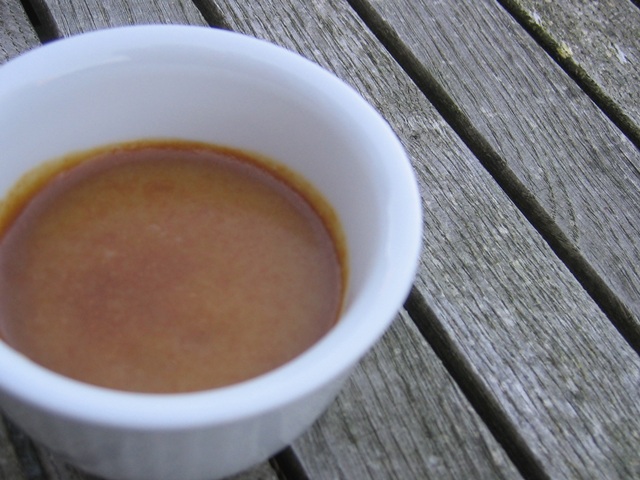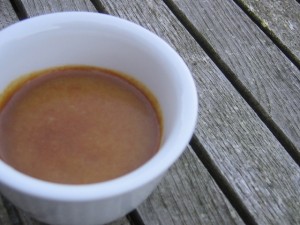
Sugar, butter, and salt: the three main food groups
 I really enjoy my work. I find teaching (and research) very rewarding, but sometimes the rewards come in mysterious and unexpected ways. One of the students I am working with spent some time over the summer in France, visiting friends. When she returned, she brought me a jar of salted butter caramel sauce from Brittany! Now THAT is rewarding.
I really enjoy my work. I find teaching (and research) very rewarding, but sometimes the rewards come in mysterious and unexpected ways. One of the students I am working with spent some time over the summer in France, visiting friends. When she returned, she brought me a jar of salted butter caramel sauce from Brittany! Now THAT is rewarding.
Brittany, which is a peninsula in the northwest corner of France, is, of course, famous for its abundant seafood and excellent apples (and fermented, sparkling cider – more on that, another time), but the first thought that comes to my mind when I think of Brittany is butter; salted butter, to be precise. Breton butter is traditionally a cultured butter, which is to say a butter that likes going to the opera on Saturday evenings. Either that, or butter which contains naturally-occurring bacteria, very much like those found in yoghurt. The bacteria either find their way into the butter via a fermentation process, or, more likely these days, by the artificial inoculation with certain bacterial cultures. Either way, this makes for a fuller, more aromatic butter, with a lot more complexity than uncultured butter. And really… what distinguished gentleman wants his butter uncultured? As if this wasn’t enough, the Bretons often season their butter with salt harvested from their coasts. The result is an unapologetically rich and fragrant butter that features heavily in Breton cooking. It’s an indispensable ingredient in Gâteau Breton and Kouign Amann, both of which could be described without exaggeration as “instant coronaries”. So, you know they must be good.
Back to the caramel, then. The jar you see above disappeared more quickly than I care to tell you. Sophia had a tiny tasting on some bread, but all the rest was consumed by me. Most of the time as a simple spread on some fresh bread for breakfast, or as a makeshift dessert of sorts. And then, one day, it was gone. As suddenly as it arrived, so it disappeared, leaving me yearning for more. So what’s a man sans caramel to do, but cook some up. The process is fairly straightforward, yet fraught with dangers. Cook the sugar over too high a heat and the bottom burns, before the top has a chance to melt. Add the cream too cold and the caramel crystallises in a sharp mess. Did you add enough salt? Who knows; there’s no way to taste this lava, without burning your mouth and tongue. Still, as I said, the process is straightforward:
 Take 100gr sugar (I use my homemade vanila sugar for this) and layer it in a large, thick-bottomed saucepan. Place this over low/medium heat and wait until it melts. Be careful not to let it catch. You’re looking for a dark blond colour, but for a richer caramel, wait until it turns auburn and it JUST starts to smoke. Do not stir, do not shake, do not even look at it with the intent to stir it: it will know and will crystallise faster than you can say “impossible crystals“. This process should take about 4 or 5 minutes. During that time, heat up 125ml of heavy cream. You can do this in the microwave or on the stovetop, but, either way, you want it nice and hot, so when it’s added to the caramel it doesn’t cool it down abruptly. Take the pot off the heat and stir the caramel/cream mixture until smooth, being careful not to get any of the superheated liquid on your skin. Add to this, 50gr of salted butter and stir again until it is incorporated. Let this cool down a little bit and then decant into lidded glass jars. It will keep for a month in the refrigerator, but, I prefer to keep it outside, so it is always the right consistency, always at the ready. Besides, in my house it never lasts more than a couple of weeks. I eat it on warm bread, on ice-cream, in crepes, and, sometimes, just on its own.
Take 100gr sugar (I use my homemade vanila sugar for this) and layer it in a large, thick-bottomed saucepan. Place this over low/medium heat and wait until it melts. Be careful not to let it catch. You’re looking for a dark blond colour, but for a richer caramel, wait until it turns auburn and it JUST starts to smoke. Do not stir, do not shake, do not even look at it with the intent to stir it: it will know and will crystallise faster than you can say “impossible crystals“. This process should take about 4 or 5 minutes. During that time, heat up 125ml of heavy cream. You can do this in the microwave or on the stovetop, but, either way, you want it nice and hot, so when it’s added to the caramel it doesn’t cool it down abruptly. Take the pot off the heat and stir the caramel/cream mixture until smooth, being careful not to get any of the superheated liquid on your skin. Add to this, 50gr of salted butter and stir again until it is incorporated. Let this cool down a little bit and then decant into lidded glass jars. It will keep for a month in the refrigerator, but, I prefer to keep it outside, so it is always the right consistency, always at the ready. Besides, in my house it never lasts more than a couple of weeks. I eat it on warm bread, on ice-cream, in crepes, and, sometimes, just on its own.
Enjoy,
Tassos
